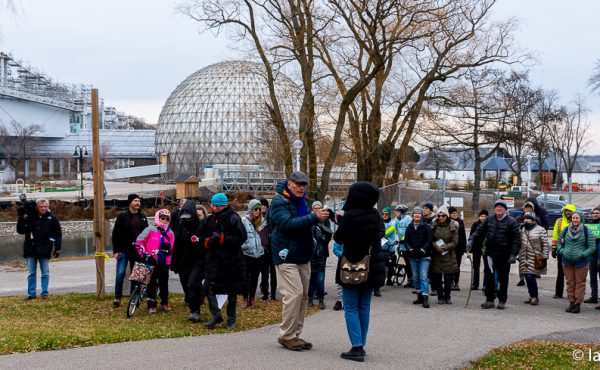
During the recent municipal election, a number of candidates spoke passionately about creating more affordable housing. A certain over-exposed downtown candidate made some suggestions during his campaign that I’ve been thinking about for years — turning the spaces above our libraries and subway stations into mixed-use affordable housing. There is little or no cost to purchase this land, and each location is usually centrally located in a community or neighbourhood.
If the City undertook such projects, they’d also become one of the big-time players in shaping the look and feel of our major intersections. Developers may not like the idea of the City developing land on such highly sought-after property (like Bathurst, Spadina, Christie, Finch, Sheppard, and High Park stations, for example) into a mid-rise, mixed-income building. But these are the intelligent steps Toronto needs to take as we begin the process of intensification.
Think this is a crazy idea? They’re planning for it in New York, according to the NY Times.
The hunt for new ways of creating moderately priced housing in places with immoderate land prices has led housing experts in New York City to an unconventional thought: Why not tear down obsolete branch libraries and replace them with libraries that not only are bigger and better, but also have apartments built on top?
In Brooklyn, a community development group has proposed tearing down four deteriorating branch libraries and redeveloping each site — an undertaking that the group says could produce more than 30,000 square feet of new library space and as many as 200 apartments for low- and moderate-income tenants.




11 comments
I would actually pay more for a place above a library. We use the library so much that it would really improve our quality of life. I’ve been eyeing the co-op on top of the library at Yonge & Eglinton for some time now with fantasies of being able to just walk downstairs whenever I wanted a book.
Building above one story libraries is a great idea in my opinion. This certain over exposed downtown candidate also proposed burying parking lots and replacing them with parks/housing which is something I think would be cost prohibitive and not totally beneficial, but we’ll see no doubt there would be several hundred committees and town halls before that could happen either. Much of the P-Parking revenue goes to the TTC, so shutting down lots for a few years to reconfigure them would bit into the TTC’s money. That and the parking lots could be a cushion for street parking removed for bike lanes. All this would require of course, wait for it, COMMITTEES and STUDIES!!
I’m also cautious about building housing above subways…that space can be loud and difficult to sleep over. It can also be hard to build a tall building over a subway station because you’d have to disrupt the subway to put in a foundation. There is a reason that most developments over subway stations are offices and were built around the same time as the subway line in the area. If these two things can be over come though, I also don’t see a problem there.
I echo Todd’s sentiment … I’d pay more to live above a library. Besides the easy access to thousands of books, it’s almost guaranteed to be quieter and cleaner. Many libraries have been newly renovated — look at the Pape-Danforth branch — and are incredibly pleasant and lovely to visit.
I’m personally quite happy with what they’ve done with my local branch, Jones. They’ve recently transformed the patch of dead concrete next to it with some manicured bushes and a pretty new bench (sadly already with some graffiti). It’s small but made a huge difference.
Matt B:”A certain over-exposed downtown candidate”
I think that one was beneath you Matt.
Dave:”Much of the P-Parking revenue goes to the TTC”
I’m open to correction but isn’t that only true of the parking at TTC stations? I thought the Toronto Parking Authority was completely separate from the TTC. I also thought it was thoroughly hypocritical of Moscoe to push ads aimed at Impark (based on the very similar logo) when the council he sits on has a very extensive carpark operation, not least the huge one under city hall.
I think Matt was being cute, re downtown candidate, totally his level. Other things lay beneath.
Is land acquisition really such a big cost of a housing project? (Can anyone comment?)
I’m a bit leery of putting development over libraries simply because many of the freestanding library buildings are both charming and award-winning on their own, and slamming a housing development over top of them would be insensitive. I would think that only a few of the system’s libraries would lend themselves to this approach – Centennial, Danforth, Thorncliffe are examples where I think it could work. But Toronto is blessed with wonderful library buildings from many different eras, and it would be a shame to lose that.
Over subways, though, great idea. Let’s start with Wellesley.
Wellesley was one of the first to be built over — that brown crap above the entrance is the parking garage of the boring/ugly apartment slab just behind.
It’s been made even more ugly by the good looking condo going in just to the east.
I’d be in favour of rebuilding over Wellesley though.
—
The Spadina branch, next to the subway entrance, is also boring, and could be build better inside of some bigger building.
—
The St. Lawrence neighbhood’s library is built into an apartment building down there — seems to work well, unfortunately not one of the prettier buildings in the area.
The Wellesley Subway station is one of only four stations to be included on Toronto’s Inventory of Heritage Properties. The others are Rosedale, Summerhill and Yorkdale. Still, knowing this, I would not mind seeing it replaced. What you notice is the big brown parking garage, more than the subway.
A key point with the subway idea is that the affordable housing would put people who USE the subway near the subway. A problem with some of the high-end condo developments that are going up near subway stations is that the well-off people who buy into them are less likely to be regular transit-users (some will be, but a smaller proportion). It makes much more sense, if possible, to put affordable housing on or near subway stations, where the inhabitants may not be able to afford cars and really do rely on transit. So this is a clever concept, if the various issues can be resolved.
However, I think it is indeed an issue, as one commenter pointed out, that land costs are actually a relatively small portion of the cost of building affordable housing (this surprised me when I learned about it in another context). So using library and subway station space might not make enough of a difference to make the project feasible.
I’m awfully surprised to hear that the Wellesley subway station, one of the ugliest in my opinion, is a “heritage” property. By all means build over it!
There really is no need for libraries to be “freestanding”. They can serve well if located in other buildings. The branch at Orchard View (Yonge and Eglinton), already mentioned above, or the St. Lawrence branch downtown, are good examples. The Deer Park branch at Yonge and St. Clair comes to mind. It’s sitting on some pretty valuable real estate. I wonder if a deal could be cut with a developer to put something on this site? The city would contribute the land. Let the developer provide the library space and, say, 20% of the apartments to be rented at less than market. By saving on land costs, I’m guessing that a developer could sell the other 80% as condos at competitive prices, or alternatively hold them and rent them at market rates, and come out ahead.
Some innovative thinking is needed at City Hall!